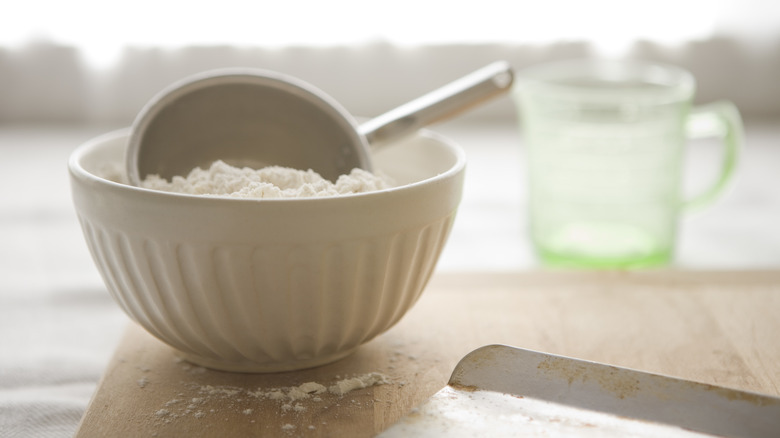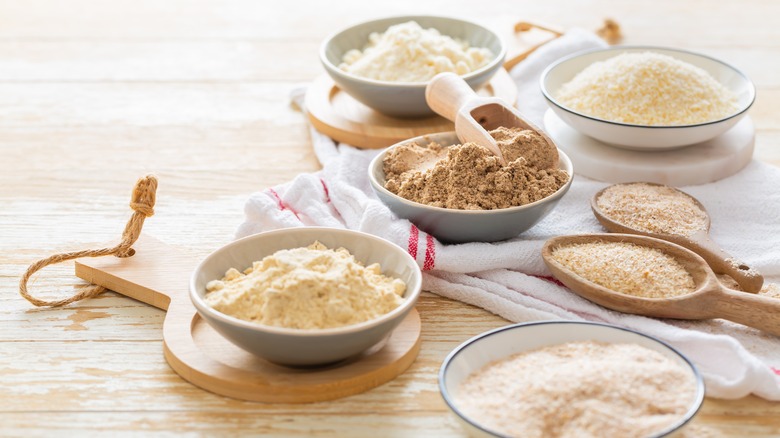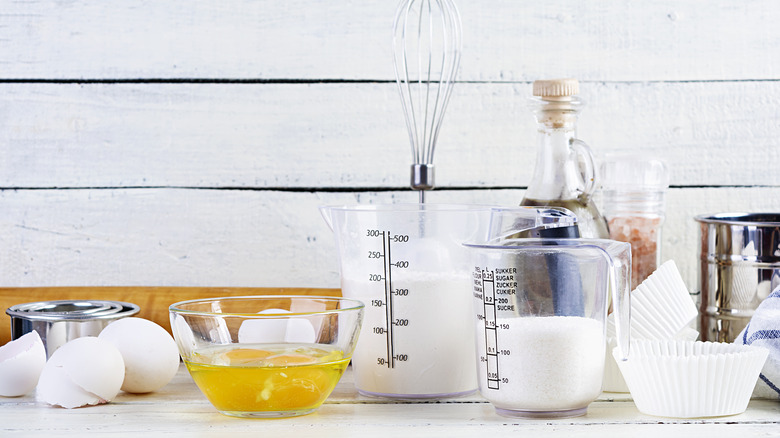The Right Way To Measure Dry Vs Wet Ingredients When Baking
There are few things more comforting than the scent of chocolate chip cookies, red velvet cupcakes, or homemade bread baking in your oven. Possibly even better is the sense of accomplishment when you enjoy your creation, especially since baking can be a challenge. Unlike cooking, baking is a science that relies on chemical reactions, making precise measurements crucial to creating moist cakes, crisp cookies, and fluffy breads.
Failing to measure ingredients properly while baking is the easiest way to ruin the results. Adding too much flour to cake batter, for instance, will result in a flat, dry cake, while too little will cause your cake to crumble apart. Similarly, using too much or too little sugar, fat, liquid, or rising agent can also lead to disastrous results, such as baked goods that are undercooked, too dry, too dense, or that burn easily.
The best way to remedy these problems is to prevent them by measuring your ingredients correctly. There is some debate about how to do this — some bakers swear by weighing ingredients while others prefer Ina Garten's fluff-and-scoop method. The truth is, each method can help you produce delicious baked goods. It's just a matter of deciding which tools you're most comfortable using.
How to measure dry ingredients correctly
Measuring dry ingredients by weight — rather than volume — is widely accepted as the most accurate method. While the weight of flour or sugar never changes, the amount that ends up inside a measuring cup might change if you pack it too full or level it off incorrectly. However, 16 ounces of flour always weighs the same, no matter how it's scooped or leveled.
To weigh your dry baking ingredients properly, you'll need a baking scale. Most scales also allow you to change the unit of weight, so you can use them for any recipe. Once you've adjusted the scale to the measurement of weight you need, set a bowl on the scale and press the "tare" button to remove the weight of the bowl from the scale's calculations. After that, slowly add your ingredients to the bowl until you reach the weights listed in your recipe. You can also use your scale to accurately measure batter into muffin tins or cake pans.
If you don't have a kitchen scale or your recipe calls for volume measurements, you can still get delicious results with measuring cups. The key here is to use them properly. Lightweight ingredients like flour become easily compacted, causing you to scoop more than you need. For these ingredients, use a separate spoon to fill your measuring cup, and then level it off with the back of a knife. Heavier ingredients, like sugar, can be scooped right from the container.
How to measure wet ingredients correctly
Though the most accurate way to measure wet ingredients is by volume — not weight — you need special tools to do so accurately. Using scoops to measure wet ingredients is almost always inaccurate because it's extremely difficult to fill a scoop to the top without spilling. This means the scoop will always hold slightly less liquid than you need.
Liquid measuring cups, on the other hand, are designed to measure liquids accurately. Though they only perform one function, they're some of the best home baking tools to invest in because they do their job so well. These cups are usually made of clear plastic or glass, and have spouts and volume measurements printed in red on the outside. The lines allow you to see exactly how much liquid you've poured into the cup.
To use liquid measuring cups properly, set them on a stable surface and look through the side of the cup while pouring your ingredients. Observing from the side helps you see when the liquid has reached the right measurement mark, whereas watching from above offers a distorted view. Once you've poured the proper amount of liquid, the spout on these cups allows you to pour it easily into your mixture without splashing.


